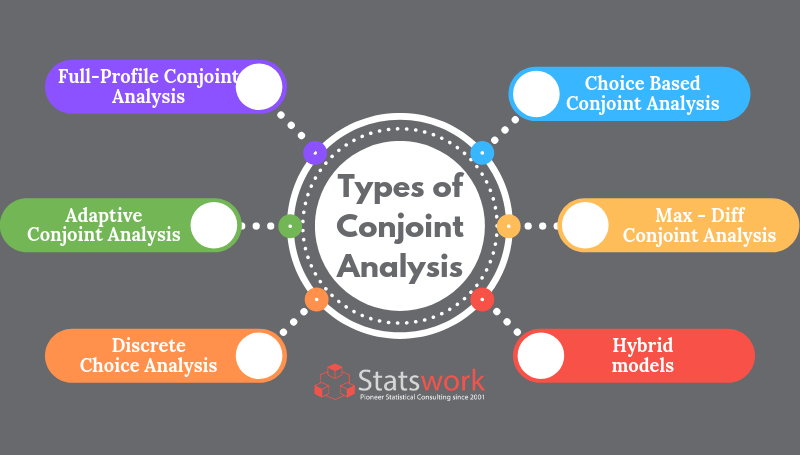Conjoint Analysis and Its Types
Conjoint analysis is a statistical technique which helps to form subsets of all possible combinations of the characteristics present in the target product. These characteristics used to determine the product’s buying choice. Conjoint analysis works on the conviction that when studied together, the relative values of the attributes are calculated better than in segregation.
Statswork is one among the country’s leader in providing Data Analysis Services and Statistical Consulting Services. Contact Statswork for availing our services.
In Conjoint Analysis, the stimuli play an important role. It is the stimuli that offer the scientists, data about the choice of the consumer. The scientists can conduct this technique with the assistance of the stimuli. However, the investigator should check that the answers are accurate because that depends on the Interpretation of the conjoint assessment.
The conjoint analysis method has discovered its applications in different fields. These disciplines include consumer branding, industrial branding, etc. The procedure offers a flexible chance for the investigator to tackle certain problems rather than conducting hypothesis testing.
Computer search routines (such as the Advanced Simulation Module of Sawtooth Software) can effectively discover ideal products based on utility, share, income or benefits criteria.
There are several methods for evaluating the reliability and validity of the conjoint analysis. A reliability test, called conjoint analysis test-retest reliability, can be used to obtain duplicated judgments that are sometimes involved in data collection. If an aggregate amount of conjoint analysis has been performed, then the assessment sample may be divided into several samples and on each sub-sample, the conjoint analysis will be performed again. This can guarantee the researcher of the reliability and validity of the conjoint analysis.

In terms of individual choices and aggregate selection shares, validations were carried out. In both ratings and decisions, reliability was evaluated.
It is important for the researcher to know that conjoint analysis and multidimensional scaling (MDS) are complementary to each other. Both depend on the subjective evaluations of the respondent. The distinction between the stimuli is that the stimuli are the combinations of attribute concentrations in joint assessment for conjoint analysis, whereas the stimuli are the products or brands of the products in MDS.
The following steps are involved while conducting conjoint analysis:
- The formulation of the problem is the first and foremost obvious step.
- The preparation of the stimuli is the next step.
- The third stage is to determine the data type to be entered.
- The fourth stage includes a procedure selection.
- The next step is to interpret the acquired outcomes.
- And the final stage is the reliability and validity assessment.
Full-profile conjoint analysis requires the strategy of showing the respondent a huge amount of complete product descriptions. The assessment of these packages gives each customer/respondent huge amount of Quantitative Data Collection. Conjoint analysis in full profile was a common method in measuring utilities of attributes. Different product descriptions (or even varying real goods) are created and submitted for acceptability or preference assessments to the respondent in the full-profile conjoint assignment.

Types of Conjoint Analysis:
Choice-based Conjoint Analysis demands that individuals select their choice to purchase whereas other types of conjoint analysis ask for alternatives to rank or rate. Choices are generally regarded as more realistic than asking individuals to grade or rate alternatives.
Based on their preference, Adaptive Conjoint Analysis differs in terms of selection sets submitted to participants. This adjustment aims to achieve the best characteristics and concentrations of the respondent so as to make the conjoint practice more effective. Each displayed package is more competitive and produces smarter information.
Max-Diff Conjoint Analysis provides a selection of packages under best / most preferred and worst / less preferred situations. Respondents can rapidly show the best and worst items in a list but often strive for the ‘middle ground’ to decipher their emotions. Max-Diff is often an easier job, as customers are well trained to make comparative decisions.
Discrete Choice Analysis (also known as stated ‘preference studies’ or an alternative particular choice-based design) is a more sophisticated type of choice-based choice. DCA surveys are especially common in transport research that looks at modal selection-the preference, for example, between a train, vehicle, and airline. CBC’s primary distinction is that it seems that continuous variables such as cost and time are included. This enables the capacity to examine the ticket’s variable expenses with different times given to travel and thus to determine the significance of travel time.
Hybrid Models have been created to serve two primary objectives: to simplify the task of information collection by placing less strain on each respondent, and to allow the assessment of chosen interactions (at the subgroup level) as well as all major (or easy) impacts at each stage. The participants assess a restricted amount in the hybrid strategy, usually no more than nine conjoint stimuli such as full profiles. Furthermore, participants directly assess the comparative significance of each attribute and the desirability of each attribute’s concentrations.
Conjoint analysis is the most effective models in extracting consumer preferences during the purchasing process into a quantitative measurement. It evaluates products or services in a way no other method can.
